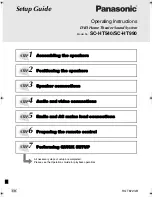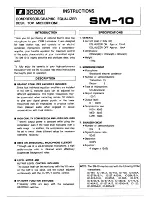
3
SECTION 1
SERVICING NOTES
The laser diode in the optical pick-up block may suffer electro-
static break-down because of the potential difference generated
by the charged electrostatic load, etc. on clothing and the human
body.
During repair, pay attention to electrostatic break-down and also
use the procedure in the printed matter which is included in the
repair parts.
The flexible board is easily damaged and should be handled with
care.
NOTES ON LASER DIODE EMISSION CHECK
The laser beam on this model is concentrated so as to be focused
on the disc reflective surface by the objective lens in the optical
pick-up block. Therefore, when checking the laser diode emis-
sion, observe from more than 30 cm away from the objective lens.
Notes on chip component replacement
• Never reuse a disconnected chip component.
• Notice that the minus side of a tantalum capacitor may be dam-
aged by heat.
Flexible Circuit Board Repairing
• Keep the temperature of the soldering iron around 270 ˚C dur-
ing repairing.
• Do not touch the soldering iron on the same conductor of the
circuit board (within 3 times).
• Be careful not to apply force on the conductor when soldering
or unsoldering.
NOTES ON HANDLING THE OPTICAL PICK-UP
BLOCK OR BASE UNIT
• MODEL IDENTIFICATION
– Rear Panel –
Power Voltage Indication
Model
Power Voltage Indication
US model
AC: 120 V
-
60 Hz 110 W
Canadian model
AC: 120 V
-
60 Hz 120 W
AEP, UK models
AC: 230 V
-
50/60 Hz 105 W
Australian model
AC: 220 – 240 V
-
50/60 Hz 120 W
Mexican model
AC: 110 – 120 V
-
50/60 Hz 120 W
Other models
AC: 110 – 120 V/220 – 240 V
-
50/60 Hz 120 W
Summary of Contents for HCD-BX2
Page 12: ...12 MEMO ...
Page 27: ...27 27 HCD BX2 DX2 DX2B 4 15 PRINTED WIRING BOARD PANEL Section ...
Page 56: ...2 MEMO ...
Page 71: ...71 HCD BX2 DX2 DX2B MEMO ...




































